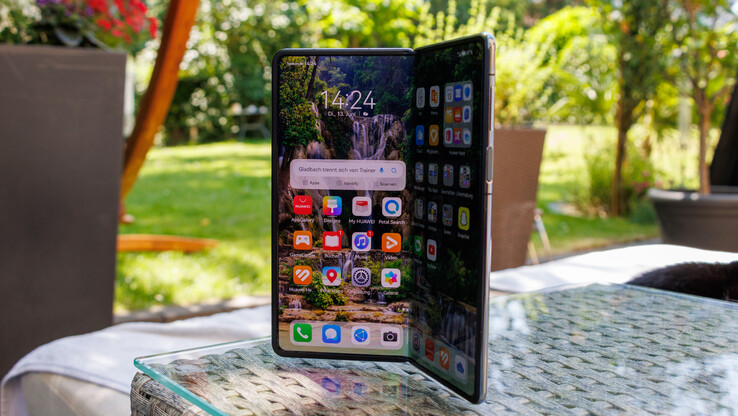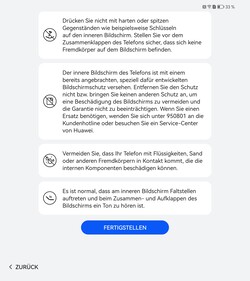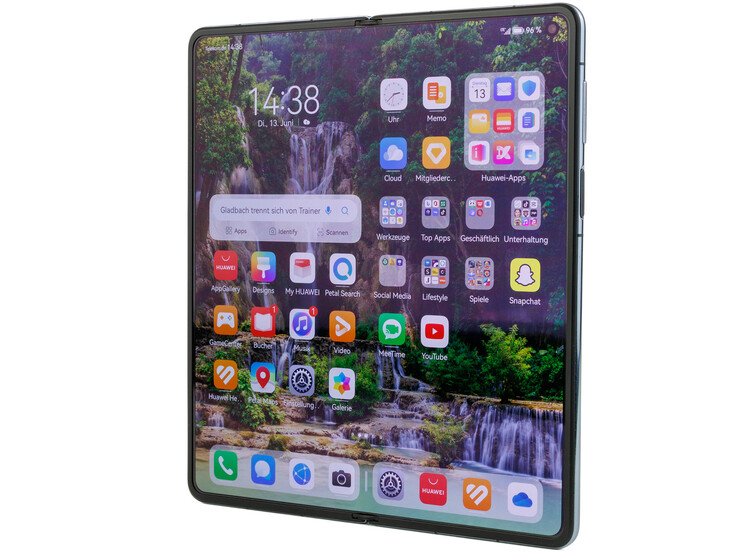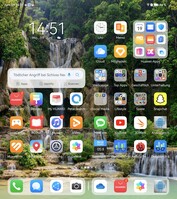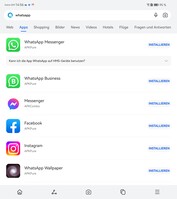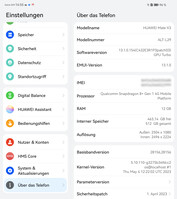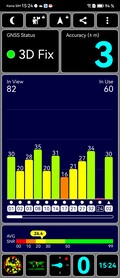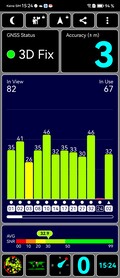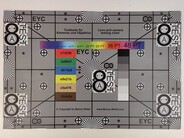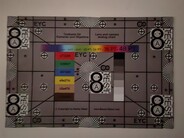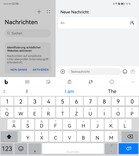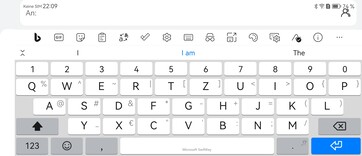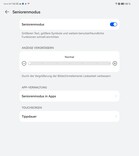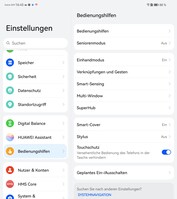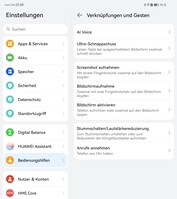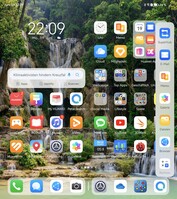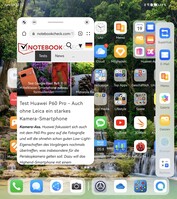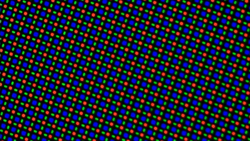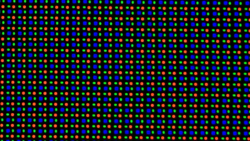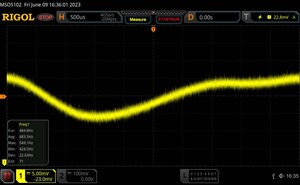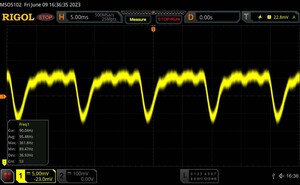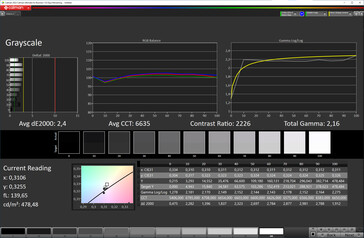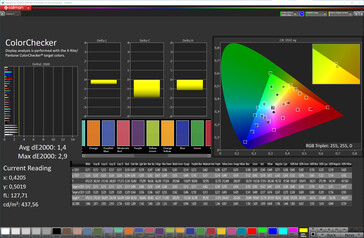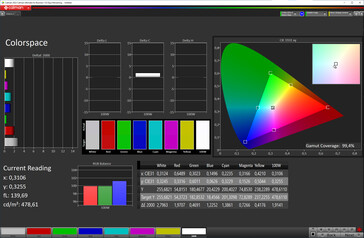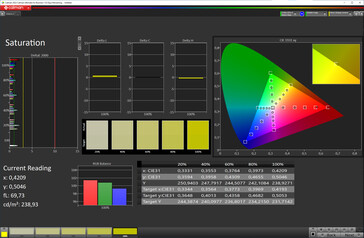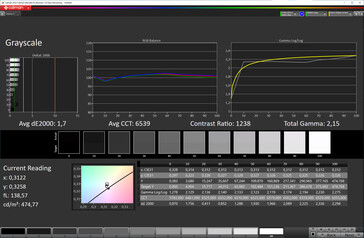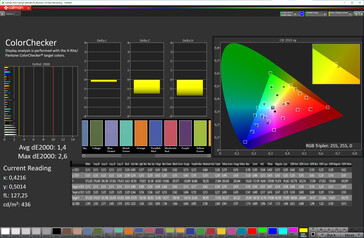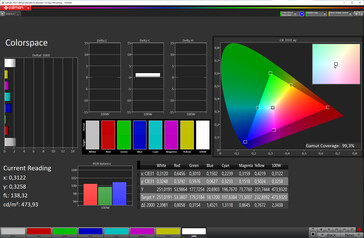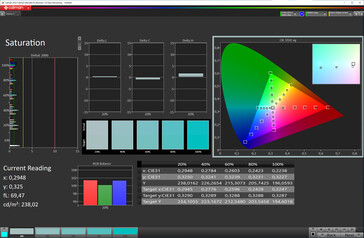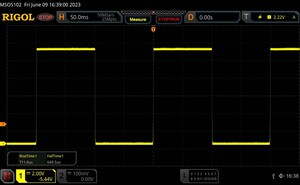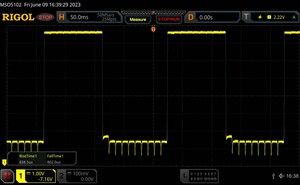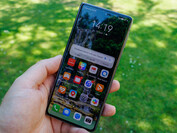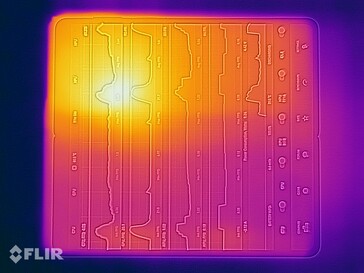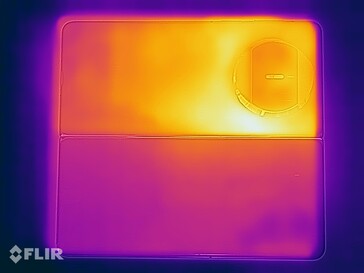Huawei Mate X3 review - Slim foldable smartphone with strong camera
The Mate X3 is the latest foldable smartphone from Huawei, which is the successor of the Mate Xs 2 and for the first time no longer relies on an external panel, but shifts the foldable screen to the inside, as is the case with the competition.
Huawei's smartphone relies on upscale features, but it is not quite inexpensive at 2,199 Euros (~$4,000). Find out everything about the Mate X3 in the following review.
Possible competitors in comparison
Rating | Date | Model | Weight | Drive | Size | Resolution | Price |
|---|---|---|---|---|---|---|---|
| 86.3 % v7 (old) | 06 / 2023 | Huawei Mate X3 SD 8+ Gen 1, Adreno 730 | 239 g | 512 GB UFS 3.1 Flash | 7.85" | 2496x2224 | |
| 89.8 % v7 (old) | 10 / 2022 | Samsung Galaxy Z Fold4 5G SD 8+ Gen 1, Adreno 730 | 263 g | 256 GB UFS 3.1 Flash | 7.60" | 2176x1812 | |
| 87.2 % v7 (old) | 03 / 2023 | Honor Magic Vs SD 8+ Gen 1, Adreno 730 | 261 g | 512 GB UFS 3.1 Flash | 7.90" | 2272x1984 | |
| 86.9 % v7 (old) | 08 / 2022 | Vivo X Fold SD 8 Gen 1, Adreno 730 | 311 g | 256 GB UFS 3.1 Flash | 8.03" | 2160x1916 | |
| 86.3 % v7 (old) | 12 / 2022 | Xiaomi Mix Fold 2 SD 8+ Gen 1, Adreno 730 | 262 g | 256 GB UFS 3.1 Flash | 8.02" | 2160x1914 |
Case - Two displays, IPX8 and Kunlun glass
The Huawei Mate X3 is available in black and dark green. Unlike all its predecessors, the foldable display is no longer on the outside, but moved to the inside, while an additional panel is integrated on the outside so that the Mate X3 can also be used when folded. It features a very slim design and is also the lightest foldable in the comparison field. Even when folded, it does not look too thick (H x W x D: 156.9 x 72.4 x 11.08 mm). The protruding camera hump pleases us visually and at least when folded, the Mate X3 does not wobble back and forth.
The build quality is convincing. The gaps are tight and very even. Careful twisting attempts do not affect the foldable and do not elicit any creaking. While Kunlun glass is used on the outside, which we already know from the P60 Pro the foldable panel is protected by a protective film that cannot be removed and is made up of several layers. One of them is made of a non-Newtonian, liquid material that is supposed to increase the impact resistance by four times. Huawei displays a corresponding note for handling the smartphone when setting it up (see screenshot).
The hinge has been reworked once again and is not only more durable but can also keep the folding display of the Mate X3 in a stable position continuously within a 130° angle. Furthermore, the phone is waterproof according to IPX8 and thus protected against complete and permanent submersion in fresh water. The Mate X3 is not spared from the typical folds of a foldable, but the edges close flush when folded and no unsightly gaps remain.
Equipment - Mate X3 with 512 GB plus memory card
Huawei's Mate X3 offers 512 GB of internal storage and the additional option to expand it with a NanoMemory Card, which can hold up to 256 GB.
The USB 3.2 (Gen. 1) port supports wired image output, including desktop mode, as well as OTG. The data transfer presents itself as very fast with 391.13 MB/s in the test.
Furthermore, an IR blaster, NFC and Bluetooth 5.2 are also on board.
Memory card reader
The Mate X3 cannot use microSD cards, but Huawei's own NanoMemory cards, which can reach a capacity of up to 256 GB.
The card reader's speed is really fast and almost completely uses the standard's possibilities (max. 90 MB/s).
| SD Card Reader - average JPG Copy Test (av. of 3 runs) | |
| Huawei Mate X3 (Huawei NanoMemory) | |
| Huawei Mate Xs 2 (Huawei NanoMemory) | |
| Sony Xperia 1 V (Angelbird AV Pro V60) | |
Cross Platform Disk Test (CPDT)
Software - The Mate X3 also still has to do without Google services
The Huawei Mate X3 ships with EMUI 13.1 in Europe, which is based on Android 12. Harmony OS 3.1 is used in the Asian markets, which does not differ in terms of looks and structure. Huawei does not provide detailed information about the update supply, but it has always been good in the past. The security patches were updated on April 1, 2023 at the time of the test and are thus no longer up-to-date.
As in the past years, the Mate X3 still has to do without Google services and the corresponding apps. Huawei's own AppGallery contains many well-known apps, but major American providers like Meta, Netflix, and Disney are missing. Many of these apps can be downloaded and installed via other platforms using the Petal search, but this is anything but easy, especially for less tech-savvy users. A better alternative can be the GBox, which is easy to install and provides the Play Store and most Google services. However, this can lead to increased battery consumption, and it is not harmless in terms of data protection.
Communication and GNSS - No 6 GHz WLAN for the Huawei Foldable
Like its predecessor, Huawei is not allowed to integrate 5G mobile in the Mate X3. Accordingly, LTE is available at best, but it has a broad frequency coverage.
Huawei's smartphone achieves fast and stable transmission rates in combination with our reference router Asus ROG Rapture GT-AXE11000. However, it does not support Wi-Fi 6E or Wi-Fi 7 and thus no 6 GHz WLAN. Huawei promises the use of VHT160, which should allow data rates beyond 1 GBit/s in the 5 GHz network without problems. However, the Mate X3 did not achieve these in the test.
| Networking | |
| Huawei Mate X3 | |
| iperf3 receive AXE11000 | |
| iperf3 transmit AXE11000 | |
| Samsung Galaxy Z Fold4 5G | |
| iperf3 receive AXE11000 | |
| iperf3 transmit AXE11000 | |
| Honor Magic Vs | |
| iperf3 receive AXE11000 | |
| iperf3 transmit AXE11000 | |
| Vivo X Fold | |
| iperf3 receive AXE11000 | |
| iperf3 transmit AXE11000 | |
| Xiaomi Mix Fold 2 | |
| iperf3 receive AXE11000 | |
| iperf3 transmit AXE11000 | |
| Huawei Mate Xs 2 | |
| iperf3 receive AXE11000 | |
| iperf3 transmit AXE11000 | |
| Average of class Smartphone | |
| iperf3 receive AXE11000 | |
| iperf3 transmit AXE11000 | |
With broad GNSS support and an integrated barometer, the Huawei Mate X3 has the best prerequisites to guide its owner safely through unknown terrain. The Satfix is very fast and accurate even indoors.
During a short bike ride, the foldable has to face comparison with the Garmin Venu 2. The recorded route of around 10 kilometers is 90 meters shorter on the X3, but the altitude meters are almost identical. A look at the detailed route shows that Huawei's smartphone records the route well, but it is sometimes a bit off track.
Phone features and voice quality
Huawei's Mate X3 supports features like VoLTE and WLAN calls, but SIP account control is not implemented into the system. It can take up to two nano-SIM cards as long as one slot is not occupied by an optional memory card. The Foldable does not have an eSIM.
The voice quality is very good when held to the ear and even louder ambient noise is reliably filtered out. The speaker is also decent but reverberates a bit.
Cameras - Mate X3 with strong triple camera
Each display of the Mate X3 has its own 8 MPix camera, both of which have an f/2.4 aperture and allow decent selfies. Videos can be recorded in Ultra HD at best, but the optics on the small display are limited to 30 FPS, while the one on the foldable panel is also capable of 60 FPS despite the identical resolution.
If you like, you can also use the main camera setup as the front camera. All you have to do is press a button in the app and the additional display then serves as a viewfinder. But especially for conventional photography, the Huawei Mate X3 can fully show its strengths and takes good pictures in daylight. Low-light pictures also turn out well, but they are a bit too reddish. The ultra wide-angle lens could have emphasized contours a bit more and the lens curvature becomes quite visible towards the edge, but it does a good job otherwise and is also responsible for macro subjects. The periscope optics allow a five-fold optical magnification, including optical image stabilization (OIS), which no other foldable smartphone offers. Digitally, even a 50x magnification is possible.
Videos can be recorded in Ultra HD with 30 or 60 FPS.
Image comparison
Choose a scene and navigate within the first image. One click changes the position on touchscreens. One click on the zoomed-in image opens the original in a new window. The first image shows the scaled photograph of the test device.
Main cameraMain cameraUltra wide-angle5x ZoomLow-Light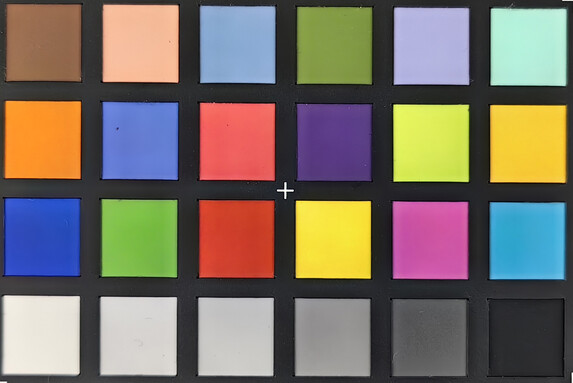
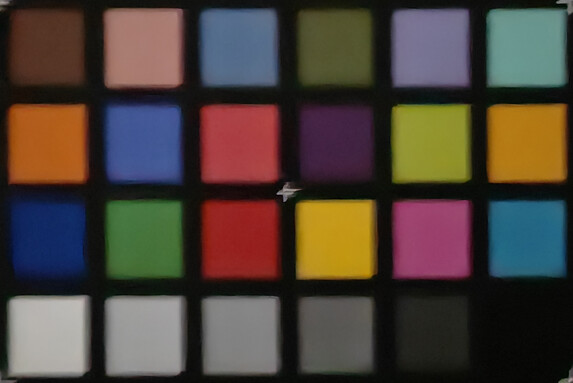
Accessories and warranty - Huawei phone with 66-watt power adapter
The Huawei Mate X3 has a 24-month warranty in Germany. It comes with a clear protective case that clips onto the back with the camera. A modular 66-Watt power supply is also included, as well as a matching USB cable (Type-A to Type-C), an additional protective film for the cover display, and a SIM tool.
Input and operation - M-Pen 2s only for China so far
Both capacitive touchscreens of the Huawei Mate X3 work very reliably in the test. However, the surface of the cover display is noticeably more slippery and offers less resistance to the fingers. Like the Galaxy Z Fold4, Huawei's foldable also supports active pen input for the main display, but the necessary Huawei M-Pen 2s is currently only available in Asia. However, it can be imported via AliExpress (148 euro).
A fingerprint sensor in the power button is available for biometric security. It has very good recognition rates and unlocks the X3 quickly. Face recognition can be used additionally or alternatively, but it is less secure.
The X3 is again capable of finger-touch input, supports numerous gestures and even has a senior mode on board, which can be used to adjust the display size and control the touchscreen's typing time, among other things.
Display - Brighter and easier on the eyes
The main display of the Huawei Mate X3 is now on the inside and grows minimally to 7.85 inches. It supports the HDR standards HLG, HDR10, and HDR10+. The refresh rate of the LTPO OLED panel reaches up to 120 Hz, the system dynamically adjusts this between 1 and 120 Hz, alternatively, it is possible to fix the refresh rate to 60 or 120 Hz.
The brightness has been improved compared to the Mate Xs 2 and now reaches an average of 969 cd/m2 when the ambient light sensor is active. This value remains on the same level even with an even distribution of bright and dark areas (APL18), and the brightness is not increased further even in HDR rendering. Those who prefer to adjust the brightness manually have 476 cd/m2 at their disposal.
The smaller cover display on the outside also relies on OLED technology, but it can get even brighter. While the brightness is almost identical in manual mode (max. 479 cd/m2), the smaller panel can increase a bit in the APL18 test and reaches up to 1,239 cd/m2.
OLED flickering is very similar in both displays. We measured a fairly constant 90 Hz depending on the zoom level, which could be a burn-in protection or black frame insertion. Zooming in closer, we can measure a frequency between 425 and 549 Hz at minimum display brightness. The Mate X3 uses PWM dimming with 1,440 Hz for both displays, which is considered comparatively easy on the eyes.
| |||||||||||||||||||||||||
Brightness Distribution: 94 %
Center on Battery: 948 cd/m²
Contrast: ∞:1 (Black: 0 cd/m²)
ΔE ColorChecker Calman: 1.4 | ∀{0.5-29.43 Ø4.77}
ΔE Greyscale Calman: 1.7 | ∀{0.09-98 Ø5}
99.3% sRGB (Calman 2D)
Gamma: 2.15
CCT: 6539 K
| |||||||||||||||||||||||||
Brightness Distribution: 95 %
Center on Battery: 1160 cd/m²
Contrast: ∞:1 (Black: 0 cd/m²)
ΔE ColorChecker Calman: 1.4 | ∀{0.5-29.43 Ø4.77}
ΔE Greyscale Calman: 2.4 | ∀{0.09-98 Ø5}
99.4% sRGB (Calman 2D)
Gamma: 2.16
CCT: 6635 K
| Huawei Mate X3 OLED, 2496x2224, 7.9" | Samsung Galaxy Z Fold4 5G Dynamic AMOLED, 2176x1812, 7.6" | Honor Magic Vs OLED, 2272x1984, 7.9" | Vivo X Fold AMOLED, 2160x1916, 8" | Xiaomi Mix Fold 2 OLED, 2160x1914, 8" | Huawei Mate Xs 2 OLED, 2480x2220, 7.8" | |
|---|---|---|---|---|---|---|
| Screen | -9% | -58% | -12% | -14% | -70% | |
| Brightness middle (cd/m²) | 948 | 913 -4% | 803 -15% | 730 -23% | 1015 7% | 763 -20% |
| Brightness (cd/m²) | 969 | 929 -4% | 809 -17% | 724 -25% | 1022 5% | 769 -21% |
| Brightness Distribution (%) | 94 | 96 2% | 97 3% | 95 1% | 98 4% | 95 1% |
| Black Level * (cd/m²) | ||||||
| Colorchecker dE 2000 * | 1.4 | 1.7 -21% | 2.27 -62% | 1.66 -19% | 1.6 -14% | 2.8 -100% |
| Colorchecker dE 2000 max. * | 2.6 | 3.6 -38% | 5.99 -130% | 2.92 -12% | 3.4 -31% | 5.9 -127% |
| Greyscale dE 2000 * | 1.7 | 1.5 12% | 3.9 -129% | 1.6 6% | 2.6 -53% | 4.3 -153% |
| Gamma | 2.15 102% | 2.16 102% | 2.25 98% | 2.28 96% | 2.22 99% | 2.24 98% |
| CCT | 6539 99% | 6515 100% | 6234 104% | 6395 102% | 6506 100% | 6457 101% |
* ... smaller is better
Screen Flickering / PWM (Pulse-Width Modulation)
| Screen flickering / PWM detected | 484 Hz | ||
The display backlight flickers at 484 Hz (worst case, e.g., utilizing PWM) . The frequency of 484 Hz is relatively high, so most users sensitive to PWM should not notice any flickering. However, there are reports that some users are still sensitive to PWM at 500 Hz and above, so be aware. In comparison: 53 % of all tested devices do not use PWM to dim the display. If PWM was detected, an average of 8083 (minimum: 5 - maximum: 343500) Hz was measured. | |||
Measurement series with fixed zoom level and different brightness settings
The analysis with Calman shows that the two displays of the Huawei Mate X3 are both well-calibrated and matched.
Display Response Times
| ↔ Response Time Black to White | ||
|---|---|---|
| 1.36 ms ... rise ↗ and fall ↘ combined | ↗ 0.711 ms rise | |
| ↘ 0.6495 ms fall | ||
| The screen shows very fast response rates in our tests and should be very well suited for fast-paced gaming. In comparison, all tested devices range from 0.1 (minimum) to 240 (maximum) ms. » 7 % of all devices are better. This means that the measured response time is better than the average of all tested devices (20.2 ms). | ||
| ↔ Response Time 50% Grey to 80% Grey | ||
| 1.64 ms ... rise ↗ and fall ↘ combined | ↗ 0.8385 ms rise | |
| ↘ 0.802 ms fall | ||
| The screen shows very fast response rates in our tests and should be very well suited for fast-paced gaming. In comparison, all tested devices range from 0.165 (minimum) to 636 (maximum) ms. » 7 % of all devices are better. This means that the measured response time is better than the average of all tested devices (31.6 ms). | ||
Outdoors, the Mate X3 remains easy to read even in sunlight and the ambient light sensors always adjust the brightness quickly.
The viewing angle stability of the foldable display remains a bit better in terms of color representation because the cover display shows a slightly warmer picture at flat viewing angles. However, this does not bother in everyday use.
Performance - Mate X3 relies on the Snapdragon 8+ Gen 1
The Huawei Mate X3 is powered by a Snapdragon 8+ Gen 1 in the 4G version and has access to a generous 12 GB of LPDDR5 working memory. Thus, the SoC is not cutting-edge, but it is still very fast and also used by many rivals.
The benchmarks are within the expected range and certify the Huawei smartphone's high performance. Even though a performance mode is available again, we did not use it. The differences are not too big, but the option is particularly noticeable in terms of heat development.
| UL Procyon AI Inference for Android - Overall Score NNAPI | |
| Samsung Galaxy Z Fold4 5G | |
| Xiaomi Mix Fold 2 | |
| Average Qualcomm Snapdragon 8+ Gen 1 (3291 - 84787, n=21) | |
| Average of class Smartphone (3769 - 81594, n=133, last 2 years) | |
| Honor Magic Vs | |
| AImark - Score v3.x | |
| Average Qualcomm Snapdragon 8+ Gen 1 (887 - 147801, n=11) | |
| Average of class Smartphone (82 - 307528, n=120, last 2 years) | |
| Xiaomi Mix Fold 2 | |
| Honor Magic Vs | |
The graphics calculations are handled by the integrated Adreno 730 which was the fastest GPU for Android smartphones in 2022. The Mate X3 delivers a convincing performance in the benchmarks and can often place itself at the top of the comparison field. Thus, there is more than enough performance for games and other graphics-intensive apps.
GFXBench (DX / GLBenchmark) 2.7: T-Rex Onscreen | 1920x1080 T-Rex Offscreen
GFXBench 3.0: on screen Manhattan Onscreen OGL | 1920x1080 1080p Manhattan Offscreen
GFXBench 3.1: on screen Manhattan ES 3.1 Onscreen | 1920x1080 Manhattan ES 3.1 Offscreen
GFXBench: on screen Car Chase Onscreen | 1920x1080 Car Chase Offscreen | on screen Aztec Ruins High Tier Onscreen | 2560x1440 Aztec Ruins High Tier Offscreen | on screen Aztec Ruins Normal Tier Onscreen | 1920x1080 Aztec Ruins Normal Tier Offscreen | 3840x2160 4K Aztec Ruins High Tier Offscreen
| 3DMark / Wild Life Extreme Unlimited | |
| Samsung Galaxy Z Fold4 5G | |
| Huawei Mate X3 | |
| Honor Magic Vs | |
| Xiaomi Mix Fold 2 | |
| Vivo X Fold | |
| Huawei Mate Xs 2 | |
| 3DMark / Wild Life Extreme | |
| Huawei Mate X3 | |
| Honor Magic Vs | |
| Xiaomi Mix Fold 2 | |
| Samsung Galaxy Z Fold4 5G | |
| Vivo X Fold | |
| Huawei Mate Xs 2 | |
| 3DMark / Wild Life Unlimited Score | |
| Samsung Galaxy Z Fold4 5G | |
| Huawei Mate X3 | |
| Xiaomi Mix Fold 2 | |
| Honor Magic Vs | |
| Huawei Mate Xs 2 | |
| 3DMark / Wild Life Score | |
| Honor Magic Vs | |
| Huawei Mate Xs 2 | |
| 3DMark / Sling Shot Extreme (ES 3.1) Unlimited Physics | |
| Huawei Mate X3 | |
| Xiaomi Mix Fold 2 | |
| Samsung Galaxy Z Fold4 5G | |
| Huawei Mate Xs 2 | |
| 3DMark / Sling Shot Extreme (ES 3.1) Unlimited Graphics | |
| Samsung Galaxy Z Fold4 5G | |
| Huawei Mate X3 | |
| Xiaomi Mix Fold 2 | |
| Huawei Mate Xs 2 | |
| 3DMark / Sling Shot Extreme (ES 3.1) Unlimited | |
| Huawei Mate X3 | |
| Xiaomi Mix Fold 2 | |
| Samsung Galaxy Z Fold4 5G | |
| Huawei Mate Xs 2 | |
| GFXBench (DX / GLBenchmark) 2.7 / T-Rex Onscreen | |
| Samsung Galaxy Z Fold4 5G | |
| Xiaomi Mix Fold 2 | |
| Huawei Mate X3 | |
| Huawei Mate Xs 2 | |
| Honor Magic Vs | |
| GFXBench (DX / GLBenchmark) 2.7 / T-Rex Offscreen | |
| Huawei Mate X3 | |
| Honor Magic Vs | |
| Xiaomi Mix Fold 2 | |
| Samsung Galaxy Z Fold4 5G | |
| Huawei Mate Xs 2 | |
| GFXBench 3.0 / Manhattan Onscreen OGL | |
| Samsung Galaxy Z Fold4 5G | |
| Xiaomi Mix Fold 2 | |
| Huawei Mate X3 | |
| Honor Magic Vs | |
| Huawei Mate Xs 2 | |
| GFXBench 3.0 / 1080p Manhattan Offscreen | |
| Honor Magic Vs | |
| Huawei Mate X3 | |
| Xiaomi Mix Fold 2 | |
| Samsung Galaxy Z Fold4 5G | |
| Huawei Mate Xs 2 | |
| GFXBench 3.1 / Manhattan ES 3.1 Onscreen | |
| Samsung Galaxy Z Fold4 5G | |
| Xiaomi Mix Fold 2 | |
| Huawei Mate X3 | |
| Honor Magic Vs | |
| Huawei Mate Xs 2 | |
| GFXBench 3.1 / Manhattan ES 3.1 Offscreen | |
| Honor Magic Vs | |
| Xiaomi Mix Fold 2 | |
| Huawei Mate X3 | |
| Samsung Galaxy Z Fold4 5G | |
| Huawei Mate Xs 2 | |
| GFXBench / Car Chase Onscreen | |
| Samsung Galaxy Z Fold4 5G | |
| Honor Magic Vs | |
| Xiaomi Mix Fold 2 | |
| Huawei Mate X3 | |
| Huawei Mate Xs 2 | |
| GFXBench / Car Chase Offscreen | |
| Huawei Mate X3 | |
| Honor Magic Vs | |
| Xiaomi Mix Fold 2 | |
| Samsung Galaxy Z Fold4 5G | |
| Huawei Mate Xs 2 | |
| GFXBench / Aztec Ruins High Tier Onscreen | |
| Samsung Galaxy Z Fold4 5G | |
| Honor Magic Vs | |
| Vivo X Fold | |
| Xiaomi Mix Fold 2 | |
| Huawei Mate X3 | |
| Huawei Mate Xs 2 | |
| GFXBench / Aztec Ruins High Tier Offscreen | |
| Huawei Mate X3 | |
| Honor Magic Vs | |
| Samsung Galaxy Z Fold4 5G | |
| Vivo X Fold | |
| Xiaomi Mix Fold 2 | |
| Huawei Mate Xs 2 | |
| GFXBench / Aztec Ruins Normal Tier Onscreen | |
| Samsung Galaxy Z Fold4 5G | |
| Honor Magic Vs | |
| Vivo X Fold | |
| Xiaomi Mix Fold 2 | |
| Huawei Mate X3 | |
| Huawei Mate Xs 2 | |
| GFXBench / Aztec Ruins Normal Tier Offscreen | |
| Huawei Mate X3 | |
| Honor Magic Vs | |
| Xiaomi Mix Fold 2 | |
| Vivo X Fold | |
| Samsung Galaxy Z Fold4 5G | |
| Huawei Mate Xs 2 | |
| GFXBench / 4K Aztec Ruins High Tier Offscreen | |
| Huawei Mate X3 | |
| Samsung Galaxy Z Fold4 5G | |
| Honor Magic Vs | |
| Vivo X Fold | |
| Xiaomi Mix Fold 2 | |
| Huawei Mate Xs 2 | |
| Jetstream 2 - 2.0 Total Score | |
| Average of class Smartphone (23.8 - 387, n=148, last 2 years) | |
| Samsung Galaxy Z Fold4 5G (Chrome 105) | |
| Average Qualcomm Snapdragon 8+ Gen 1 (76.2 - 204, n=23) | |
| Honor Magic Vs (Chrome 111) | |
| Huawei Mate X3 (Huawei Browser 13.0.4) | |
| Xiaomi Mix Fold 2 (MiUI-Browser 14.7) | |
| Speedometer 2.0 - Result 2.0 | |
| Average of class Smartphone (15.2 - 643, n=120, last 2 years) | |
| Average Qualcomm Snapdragon 8+ Gen 1 (69.1 - 196, n=18) | |
| Samsung Galaxy Z Fold4 5G (Chrome 105) | |
| Honor Magic Vs (Chome 111) | |
| WebXPRT 4 - Overall | |
| Average of class Smartphone (27 - 306, n=144, last 2 years) | |
| Samsung Galaxy Z Fold4 5G (Chrome 105) | |
| Average Qualcomm Snapdragon 8+ Gen 1 (69 - 159, n=21) | |
| Huawei Mate X3 (Huawei Browser 13.0.4) | |
| Honor Magic Vs (Chrome 111) | |
| Xiaomi Mix Fold 2 | |
| WebXPRT 3 - Overall | |
| Average of class Smartphone (38 - 380, n=30, last 2 years) | |
| Samsung Galaxy Z Fold4 5G (Chrome 105) | |
| Average Qualcomm Snapdragon 8+ Gen 1 (106 - 224, n=14) | |
| Honor Magic Vs (Chrome 111) | |
| Octane V2 - Total Score | |
| Samsung Galaxy Z Fold4 5G (Chrome 105) | |
| Huawei Mate X3 (Huawei Browser 13.0.4) | |
| Average of class Smartphone (2228 - 126661, n=195, last 2 years) | |
| Average Qualcomm Snapdragon 8+ Gen 1 (17622 - 61536, n=24) | |
| Honor Magic Vs (Chrome 111) | |
| Xiaomi Mix Fold 2 (MiUI-Browser 14.7) | |
| Huawei Mate Xs 2 (Huawei Browser 12.1) | |
| Mozilla Kraken 1.1 - Total | |
| Xiaomi Mix Fold 2 (MiUI-Browser 14.7) | |
| Average of class Smartphone (257 - 28190, n=155, last 2 years) | |
| Honor Magic Vs (Chrome 111) | |
| Average Qualcomm Snapdragon 8+ Gen 1 (665 - 1707, n=22) | |
| Huawei Mate X3 (Huawei Browser 13.0.4) | |
| Samsung Galaxy Z Fold4 5G (Chrome 105) | |
* ... smaller is better
| Huawei Mate X3 | Samsung Galaxy Z Fold4 5G | Honor Magic Vs | Vivo X Fold | Xiaomi Mix Fold 2 | Huawei Mate Xs 2 | Average 512 GB UFS 3.1 Flash | Average of class Smartphone | |
|---|---|---|---|---|---|---|---|---|
| AndroBench 3-5 | -10% | -15% | -5% | 11% | -23% | -7% | 8% | |
| Sequential Read 256KB (MB/s) | 1953.41 | 1854.98 -5% | 1695.2 -13% | 1850.6 -5% | 1882.11 -4% | 1850.72 -5% | 1874 ? -4% | 2240 ? 15% |
| Sequential Write 256KB (MB/s) | 1479.42 | 1251.57 -15% | 1296.5 -12% | 1405 -5% | 1783.27 21% | 739.83 -50% | 1338 ? -10% | 1877 ? 27% |
| Random Read 4KB (MB/s) | 261.78 | 321.87 23% | 270.2 3% | 293.4 12% | 342.67 31% | 260.49 0% | 290 ? 11% | 298 ? 14% |
| Random Write 4KB (MB/s) | 466.74 | 265.9 -43% | 300.1 -36% | 358.1 -23% | 446.48 -4% | 301.38 -35% | 357 ? -24% | 345 ? -26% |
Emissions - Foldable with dual speaker
Temperature
The surfaces of Huawei's Mate X3 remain cool over a large area even under constant load, although the demanding Burnout benchmark is already used in this test.
Unfortunately, the performance stability of the SoC is similarly weak. Although it remains largely stable for the first six runs of the 3DMark Wild Life stress test, it then drops sharply so that only 40% of the original performance is still available.
(±) The maximum temperature on the upper side is 41.6 °C / 107 F, compared to the average of 35.2 °C / 95 F, ranging from 21.9 to 247 °C for the class Smartphone.
(±) The bottom heats up to a maximum of 40.8 °C / 105 F, compared to the average of 34 °C / 93 F
(+) In idle usage, the average temperature for the upper side is 29.8 °C / 86 F, compared to the device average of 32.9 °C / 91 F.
3DMark Wild Life Stress Test
| 3DMark | |
| Wild Life Stress Test Stability | |
| Honor Magic Vs | |
| Huawei Mate Xs 2 | |
| Samsung Galaxy Z Fold4 5G | |
| Huawei Mate X3 | |
| Wild Life Extreme Stress Test | |
| Xiaomi Mix Fold 2 | |
| Honor Magic Vs | |
| Samsung Galaxy Z Fold4 5G | |
| Huawei Mate Xs 2 | |
| Huawei Mate X3 | |
Speaker
The two speakers of Huawei's Mate X3 provide a pleasant soundscape at medium volume, but the mids and lows are about too thin at maximum.
The USB port can be used to connect headphones and external speakers to the smartphone. Bluetooth 5.2 is available wirelessly, which supports the audio codecs SBC, AAC, LDAC and L2HC.
Huawei Mate X3 audio analysis
(+) | speakers can play relatively loud (86.5 dB)
Bass 100 - 315 Hz
(-) | nearly no bass - on average 19.9% lower than median
(±) | linearity of bass is average (12.6% delta to prev. frequency)
Mids 400 - 2000 Hz
(+) | balanced mids - only 3.8% away from median
(+) | mids are linear (4.9% delta to prev. frequency)
Highs 2 - 16 kHz
(±) | higher highs - on average 7.4% higher than median
(+) | highs are linear (3.4% delta to prev. frequency)
Overall 100 - 16.000 Hz
(±) | linearity of overall sound is average (18.2% difference to median)
Compared to same class
» 18% of all tested devices in this class were better, 8% similar, 74% worse
» The best had a delta of 11%, average was 35%, worst was 134%
Compared to all devices tested
» 38% of all tested devices were better, 8% similar, 54% worse
» The best had a delta of 4%, average was 24%, worst was 134%
Samsung Galaxy Z Fold4 5G audio analysis
(+) | speakers can play relatively loud (87.4 dB)
Bass 100 - 315 Hz
(-) | nearly no bass - on average 20.6% lower than median
(±) | linearity of bass is average (9.7% delta to prev. frequency)
Mids 400 - 2000 Hz
(+) | balanced mids - only 4% away from median
(+) | mids are linear (3.9% delta to prev. frequency)
Highs 2 - 16 kHz
(±) | higher highs - on average 6% higher than median
(+) | highs are linear (3.5% delta to prev. frequency)
Overall 100 - 16.000 Hz
(±) | linearity of overall sound is average (16.3% difference to median)
Compared to same class
» 6% of all tested devices in this class were better, 5% similar, 89% worse
» The best had a delta of 11%, average was 35%, worst was 134%
Compared to all devices tested
» 26% of all tested devices were better, 6% similar, 68% worse
» The best had a delta of 4%, average was 24%, worst was 134%
Battery life - Short runtimes in opened state
Power consumption
The power consumption measurements already show that the Mate X3's foldable display is quite energy-hungry despite LTPO. The comparatively high power consumption under load is due to the Burnout benchmark.
The 4,800 mAh battery is charged with up to 66 watts via cable, which took less than 50 minutes in the test. Up to 50 watts are possible wirelessly, and the X3 can also handle reverse wireless charging.
| Off / Standby | |
| Idle | |
| Load |
|
Key:
min: | |
| Huawei Mate X3 4800 mAh | Samsung Galaxy Z Fold4 5G 4400 mAh | Honor Magic Vs 5000 mAh | Xiaomi Mix Fold 2 4500 mAh | Average Qualcomm Snapdragon 8+ Gen 1 | Average of class Smartphone | |
|---|---|---|---|---|---|---|
| Power Consumption | 48% | 20% | 43% | 32% | 31% | |
| Idle Minimum * (Watt) | 0.81 | 0.89 -10% | 1.3 -60% | 0.97 -20% | 1.006 ? -24% | 0.847 ? -5% |
| Idle Average * (Watt) | 4.26 | 0.96 77% | 1.7 60% | 1.37 68% | 1.834 ? 57% | 1.446 ? 66% |
| Idle Maximum * (Watt) | 4.45 | 1.13 75% | 2 55% | 1.48 67% | 1.984 ? 55% | 1.63 ? 63% |
| Load Average * (Watt) | 10.11 | 4.32 57% | 7 31% | 3.98 61% | 5.68 ? 44% | 6.95 ? 31% |
| Load Maximum * (Watt) | 11.58 | 6.56 43% | 10.1 13% | 6.83 41% | 8.44 ? 27% | 11.3 ? 2% |
* ... smaller is better
Power consumption: Geekbench (150 cd/m²)
Power consumption: GFXBench (150 cd/m²)
Battery life
We first tested the battery runtimes with the foldable main display and dynamic refresh rate. In the WLAN test with adjusted display brightness (150 cd/m²), the runtime is short at less than eight hours. If you only use the cover display, you can achieve about 10.5 hours. That is more, but not a particularly good result.
| Battery runtime - WiFi v1.3 | |
| Huawei Mate X3 | |
| Samsung Galaxy Z Fold4 5G | |
| Honor Magic Vs | |
| Vivo X Fold | |
| Xiaomi Mix Fold 2 | |
| Huawei Mate Xs 2 | |
Pros
Cons
Verdict - Attractive foldable that lacks not only GMS
Huawei's Mate X3 is technically a good foldable smartphone that can convince with bright and accurate displays that also offer PWM dimming with 1,440 Hz. In addition, Huawei provides ample memory, an IR blaster, an optional memory expansion, and a really good camera setup, but its good overall rating is reduced by the color management.
The Huawei Mate X3 will remain an exotic device. Not only the missing Google services are responsible for that, but especially the high price and the weak battery runtimes.
Despite the high price, buyers will have to put up with a few cuts: Besides 5G, the lack of support for the 6 GHz WLAN, no Google services, no eSIM support, and especially the comparatively short battery runtimes. In addition, there is an uncertain update schedule. That is a pity because the Mate X3 is the slimmest and lightest foldable so far and can convince in many other areas.
Strong alternatives are above all the Galaxy Z Fold4 but also the Honor Magic Vs.
Price and availability
The Mate X3 can be purchased for 2,199 Euros directly from the Huawei store but is also available from Cyberport or MediaMarkt.
Huawei Mate X3
- 06/20/2023 v7 (old)
Daniel Schmidt
Transparency
The selection of devices to be reviewed is made by our editorial team. The test sample was provided to the author as a loan by the manufacturer or retailer for the purpose of this review. The lender had no influence on this review, nor did the manufacturer receive a copy of this review before publication. There was no obligation to publish this review. As an independent media company, Notebookcheck is not subjected to the authority of manufacturers, retailers or publishers.
This is how Notebookcheck is testing
Every year, Notebookcheck independently reviews hundreds of laptops and smartphones using standardized procedures to ensure that all results are comparable. We have continuously developed our test methods for around 20 years and set industry standards in the process. In our test labs, high-quality measuring equipment is utilized by experienced technicians and editors. These tests involve a multi-stage validation process. Our complex rating system is based on hundreds of well-founded measurements and benchmarks, which maintains objectivity. Further information on our test methods can be found here.


